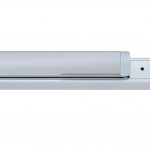Last week I wrote about fire doors vs. fire exits, and I mentioned that I would try to change/clarify the Merriam-Webster definition for “fire-exit bolt.” I received this Quick Question:
What IS a fire-exit bolt?
Great question! Here is the Merriam-Webster definition:
 I believe this definition is referring to panic hardware, which is also called an exit device. Although the ANSI/BHMA Standard A156.3 uses the term “exit devices”, I prefer “panic hardware” because this term is defined in the model codes. The definition for panic hardware from the International Building Code (IBC): A door-latching assembly incorporating a device that releases the latch upon the application of a force in the direction of egress travel. See “Fire exit hardware.”
I believe this definition is referring to panic hardware, which is also called an exit device. Although the ANSI/BHMA Standard A156.3 uses the term “exit devices”, I prefer “panic hardware” because this term is defined in the model codes. The definition for panic hardware from the International Building Code (IBC): A door-latching assembly incorporating a device that releases the latch upon the application of a force in the direction of egress travel. See “Fire exit hardware.”
The term “fire exit hardware” is also defined…in short, this is a type of panic hardware that may be installed on fire doors. The IBC definition: Panic hardware that is listed for use on fire door assemblies.
There are a few things about the Merriam-Webster definition that are confusing:
- Since the term “fire exit” is not defined in the model codes or in the Merriam-Webster dictionary, it’s not clear which doors this hardware is required for.
- One could argue that panic hardware does not incorporate a “bolt” in the normal use of the word with regard to hardware, as this would typically refer to a deadbolt. Most panic hardware has latches rather than bolts.
- While panic hardware is used on “exit doors” AKA doors in a means of egress, there are specific locations where panic hardware is required. It is not required for all public buildings.
- The IBC requires panic hardware for doors that lock or latch and serve an assembly or educational occupancy with an occupant load of 50 people or more, or a high hazard occupancy with any occupant load.
- NFPA 101 – Life Safety Code requires panic hardware for doors that lock or latch and serve an assembly, educational, or day care occupancy with an occupant load of 100 people ore more, or an area of high hazard contents with an occupant load of more than 5.
- There are additional locations such as doors serving rooms housing electrical equipment and refrigeration machinery rooms that are required to have panic hardware.
So the term fire-exit bolt is intended to mean panic hardware, and fire exit hardware is a type of panic hardware that can be used on fire doors. Using the terms defined in the model codes will help to clarify the meaning and reduce confusion.
You need to login or register to bookmark/favorite this content.










When I think of “fire exit bolt” i think about the heat actuated bolt on the bottom edge of a set of fire doors that utilize top rod only exit devices. i had always heard them referred to as a “Fire Bolt”.
Good point, Ed! I usually use the term “auxiliary fire pin” for that, but I can see where it could be confusing.
– Lori
When installing vertical rod devices less bottom rod on a pair of doors, you are supposed to install a “firebolt” The bolt is always retracted until heat reaches a certain temperature, then it ejects securing the pair of doors.
It is absolutely NOT meant for exits ever! It is to prevent smoke and flame from penetrating and/or moving within a space in a fire.
The doors are also supposed to be clearly marked as “NOT AN EXIT”
This is my understanding of the definition also not meant for rim or mortise devices only vertical rod less bottom rod.
Hi Sebastian –
I have also heard the auxiliary fire pin called a fire bolt, so I can see where the terminology could be confusing.
But just to clarify, fire exit hardware installed “less bottom rod” (LBR) with an auxiliary fire pin can be used on doors in a means of egress. The pin doesn’t project until the temperature is much too high for anyone to survive. At that point the fire door assembly is no longer used for egress and the purpose is to deter the spread of fire.
Here is the section from NFPA 101 that allows the pin:
7.2.1.5.1 Door leaves shall be arranged to be opened readily from the egress side whenever the building is occupied.
7.2.1.5.2* The requirement of 7.2.1.5.1 shall not apply to door leaves of listed fire door assemblies after exposure to elevated temperature in accordance with the listing, based on laboratory fire test procedures.
A.7.2.1.5.2 Some fire door assemblies are listed for use with fire pins or fusible links that render the door leaf release inoperative upon exposure to elevated temperature during a fire. The door leaf release mechanism is made inoperative where conditions in the vicinity of the door opening become untenable for human occupancy, and such door opening no longer provides a viable egress path.
Here is a Decoded article about the LBR application: https://idighardware.com/2012/07/decoded-less-bottom-rod-fire-exit-hardware/
– Lori
The term “fire exit hardware”
Based on the occupant load, could a mortise lock be used on a “fire exit”?
Hi Alex –
Yes – a mortise lock can be used on a fire door and a door in a means of egress (AKA “fire exit”), as long as the door is not serving a space that requires panic hardware/fire exit hardware.
– Lori